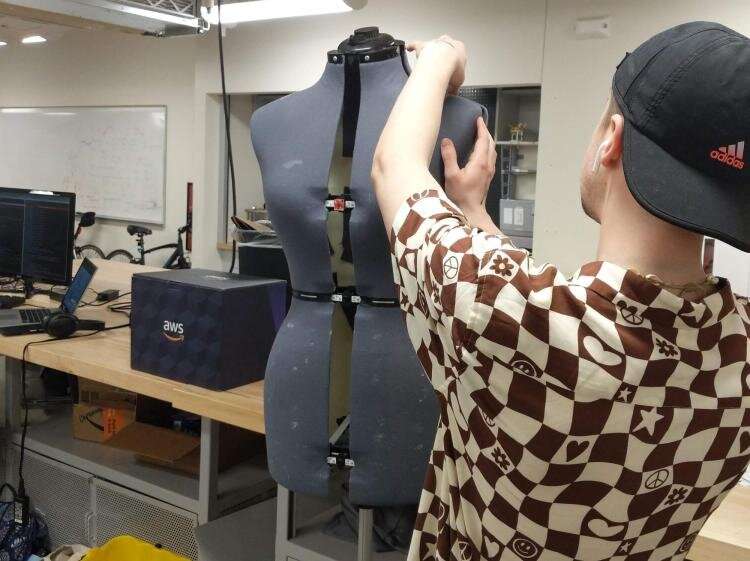Creating a drag-friendly garment that changes in real time

Sarah Aguasvivas Manzano and her team’s latest work has real-world, practical use. Wearable technology is being explored in the space industry for astronauts and big tech companies are eager for improvements to the inter-connected watches and other personal devices that increasingly support and streamline modern living.
But the CU Boulder team decided to make their own project in the wearables space just a little more … fabulous.
The team, called Escamatrónicas, is composed of Aguasvivas Manzano along with rising junior LeeLee James and rising seniors Nathan Straub and Zixi Yuan. Together they have designed a garment for drag queens that features neural networks and other creative technology. The idea is to have the garment respond and react to gestures when the queens perform with them on stage. James said this garment in particular is supposed to be like eye candy in terms of visual components, with sequencing scales that move based on the position of the person wearing it.
Aguasvivas Manzano’s research interests include soft robotics—focusing on the design, control and fabrication of robots composed of compliant material, such as hydrogels, fabrics, composites and more. She also has a particular interest in the deployment of learning, modeling and control of soft robots that simply cannot accommodate large and powerful computers in their physical design while still being effective. A light garment like this one for example—that reacts to the physical environment in real-time—requires a lot of computation and would previously have required a lot of hardware space. However, that aspect is no longer a limiting factor in the overall design and in this case the team created a compiler to translate forward inference computation for neural networks into practice to address those limitations.
“Neural networks are computational models loosely patterned after the human brain and they are now very ubiquitous,” she said. “Here I created a compiler that allowed us to automate the code-writing process. So now we can write code that can be interpreted in microcontrollers—tiny little computers that don’t have much memory or take up much space.”
James’ personal work as a technologically-empowered drag queen—documented on her YouTube Channel—gave the team inspiration to make a project that was definitely outside of the box. When it is finished there will be various sensor networks placed throughout the design, including at the hips, one at each knee, the shoulders and the sternum, Aguasvivas Manzano said.
“There’s a lot of design fabrication and sewing, but also programming as well as using our compiler (nn4mc) to offload the neural network,” Aguasvivas Manzano said.
As they move forward with the project, the team will continue to offload more efficient computation onto the garment so that the computer inside does not consume as much power. Doing so will improve usability, functionality and battery life.
The undergraduates are required to write a paper about their work for UROP, but Aguasvivas Manzano said the team also intends to turn the project into a white paper and add it to arXiv, since the project showed both creative skill and high-quality technical know-how.
Aguasvivas Manzano finished her Ph.D. this spring and will work for Apple. She said that the team could not have done this type of research without the support they received from the College of Engineering and Applied Sciences, the Correll Lab, and the Intelligent Robotics Lab.
“In the five years I have been here, I could not have been happier with the culture—particularly in the computer science department. It was really refreshing compared to other universities,” she said. “My advisor (Associate Professor Nikolaus Correll) and the university itself enabled creative thinking—fostering out-of-the-box thinking that I haven’t seen in other institutions.”
James echoed similar sentiments, saying that everything she has wanted to do for research has not only been allowed, but encouraged.
“The most impactful thing for me was having Sarah for this process,” she said. “I have access to all these really amazing people and all these resources, but not only that, I feel totally free to utilize any of those people or tools and research to do anything and everything that comes to my mind.”
Carpentry Compiler helps woodworkers design objects that they can actually make
Sarah Aguasvivas Manzano et al, High-bandwidth nonlinear control for soft actuators with recursive network models, arXiv:2101.01139 [cs.RO] arxiv.org/abs/2101.01139
Citation:
Creating a drag-friendly garment that changes in real time (2022, June 21)
retrieved 21 June 2022
from https://techxplore.com/news/2022-06-drag-friendly-garment-real.html
This document is subject to copyright. Apart from any fair dealing for the purpose of private study or research, no
part may be reproduced without the written permission. The content is provided for information purposes only.
For all the latest Technology News Click Here
For the latest news and updates, follow us on Google News.

